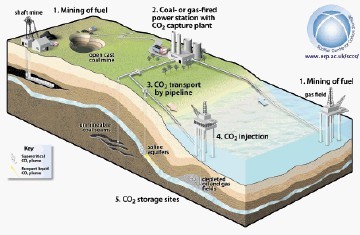
The UK’S Energy Technology Institute is seeking partners for a project to deliver a means of providing assurance that carbon dioxide is securely stored deep underground beneath the North Sea.
It is anticipated that the first commercial store in the UK will be commissioned in 2016. A system capable of detecting changes in the environment directly attributable to leakage from a CO2 store has to be ready by then, which means a “serviceable” system has to be ready by the end of 2015.
The ETI is prepared to provide up to £5million in a project to develop and demonstrate such systems
It wishes that the same tools developed will be used for both baseline and injection phase monitoring, with baseline surveys of a candidate subsea store complete before injection begins.
The organisation has calculated that the optimum way of delivering an affordable, secure and sustainable UK power mix for 2050 is to have a mix of fossil fuel plants fitted with carbon capture and storage (CCS), nuclear and renewable energy.
In its Carbon Capture and Storage Programme, the ETI has already launched a demonstration capture project targeting pre-combustion CO2 capture from coal, and is commissioning a second capture project on post combustion capture from gas-fired plant.
On storage, two research projects have been completed, one on Measuring, Monitoring and Verification (MMV) requirements for the UK and the other making an assessment of the UK’s storage potential (UKSAP, the UK Storage Appraisal Project).
Together with insights claimed from the design studies completed as part of the Government’s limited CCS competition, the ETI says it has used these studies to identify capability gaps in the UK which need to be addressed in MMV.
The most important gap to be filled is for the development of systems capable of detecting and measuring any leak in the shallow subsurface and the marine environment.
Although leakage is expected to be very unlikely in practice, such systems will be important to provide assurance to regulators, storage providers and other stakeholders for the storage sector of the CCS industry.
Most of the CO2 storage potential in UK waters exists in saline aquifers of different types. In some the CO2 will be trapped as a liquid by confining cap rock and lateral faults or other structure: in others migration of CO2 over large areas within the aquifer will be expected. Some CO2 will dissolve in the brine.
Research has demonstrated that a “sizeable amount” of the potential saline aquifer capacity is in relatively shallow reservoirs (around 1,200m deep).
Depleted oil and gas reservoirs are also considered to be attractive stores, and the ETI suggests these may start their life storing gaseous CO2 before converting to dense phase storage as the pressure rises.
“Cap rocks in both depleted oil and gas reservoirs and saline aquifers in the North Sea are likely to have been penetrated by many wells, and one should expect all sizeable stores to have these and other potential leakage pathways which, although unlikely to cause a release, need to be monitored as part of managing the risks of storage,” says the ETI in its call for proposals docmentation.
Monitoring technology for the marine and shallow subsurface environments will be relevant in all but a very few circumstances. It will be deployed in baseline surveys, the injection phase and post closure phases of storage. And it will cover the whole store including subsea pipelines and fittings.
However, it will form only part of a store’s monitoring plan, being complemented by deep and downhole monitoring techniques.
The deadline for notification of intention to submit a proposal is June 15 and the closing date is June 29.
